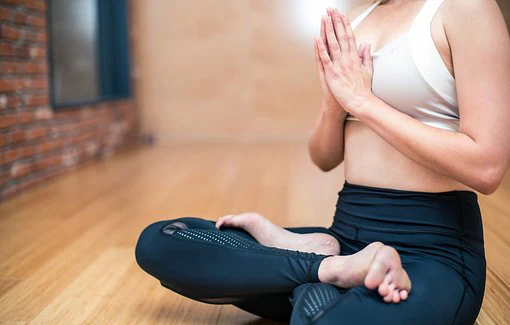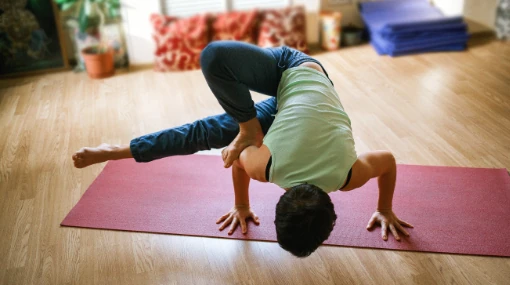Back to Basics: 9 types of Yoga Explained
Thursday, February 08, 2018, 10:20 AM
Scrolling through Facebook or the news, you might come across some unusual new yoga classes: yoga with bubbles, yoga and beer, yoga raves, and even yoga and tacos. While these can be fun classes to attend, they can cloud the true purpose of many yoga practices.
Each type of yoga has a specific focus and provides unique benefits to the practitioner.

Hatha
Hatha yoga is one of the original six branches of yoga. In Sanskrit "hatha" means physical posture, so essentially Hatha yoga covers all types of yoga.
When you attend a hatha yoga class at a studio you can expect a slower-paced class that focuses on asana (postures) and pranayama (breathing techniques). It is great choice for beginners and for those looking to deepen their knowledge of individual postures.
Vinyasa
Vinyasa means "to flow." Vinyasa yoga is a dynamic practice that focuses on continuous, flowing movements with transitions linked to the breath. This title is often applied to power classes that focus on strength. This type of yoga is where you will typically find loud, upbeat music and other "trendy" gimmicks, such as the aforementioned bubbles.
Vinyasa Yoga does not follow a specific sequence so it is perfect for those looking to explore movement and build strength in different ways. If you love the dance of yoga but are not looking for a physically demanding class, look for "slow flow" or "beginner flow" classes.

Ashtanga
Ashtanga yoga is made up of six series, beginning with the primary series. In this strict practice, the student works with a teacher to perfect the first series before moving on to the next series.
Ashtanga practitioners move though the set of poses quickly, using the breath to link postures. It is great for the dedicated practitioner who strives for perfection.
Iyengar
B.K.S. Iyengar founded Iyengar Yoga in the 1970s. It is a precise and detail-oriented practice, focusing on proper alignment and sequencing of 200 classical yoga postures. This practice utilizes a variety of props to help the student achieve proper form no matter their level of ability.
Iyengar is seen as a pure form of yoga and offers a wealth of knowledge about the structure of both the body and the yoga pose. It is great for those wanting to have an intimate awareness of each posture, or for those re-entering their practice after an injury.
Anusara
Anusara is a branch of Iyengar Yoga, but with a light-hearted emphasis on self-acceptance and the joy of the practice. Ansuara yoga teachers create playful and uplifting classes that encourage students to find the goodness in their personal expression of each pose.
This spiritual and creative type of yoga is designed for everyone, but is particularly beneficial for those suffering from low self-esteem or anxiety.

Yin
Yin yoga is all about peace. It focuses on lengthening muscles and connective tissues in a calm, meditative environment. The room is generally dimly lit with soft music playing.
In Yin, students hold few postures for a longer stretch of time — usually five minutes or more. The poses are passive, meaning gravity does the work while the student focuses on breathing and relaxing the body.
Yin yoga postures often focus on stretching the hips, inner thighs, and the psoas muscle (the primary muscle that connects the torso to the legs). Many yogis believe that emotions are stored in these areas of the body, so Yin classes can act as a way to release emotions and stress, balancing the mind and body.
Kundalini
Kundalini yoga practitioners believe there is an energy source located at the base of the spine, coiled like a snake. The yoga practice is made up of large, invigorating, and fluid movements meant to awaken the energy and move it up the spine.
Once the energy moves up the spine it is released out of the crown of the head. This is believed to open the seventh chakra (called "Sahasrara" in Sanskrit), which is connected to enlightenment and spiritual connection.
This largely spiritual class is best suited for those seeking a connection to their higher selves.
Bikram
Bikram is the original hot yoga. It was developed by Bikram Chaudhury in the 1970s. The practice is performed in bright-lit room heated to 40 degrees Celsius, with a 40% humidity level.
Practitioners perform the same 26 postures twice in every class, plus two breathing exercises meant to build internal heat. This is very physical class that encourages practitioners to push their limits. The mind-body connection is not a focus in this type of yoga, making it a great option for those using yoga as purely a form of exercise.
Moksha
Moksha yoga (internationally known as Modo Yoga) was founded in Toronto in 2004. Classes are held in studios that are socially and environmentally conscious, focusing on the community of yoga rather than just the individual practice.
Moksha is practised in a heated room, much like Bikram, and essentially follows the same sequence in every class. There is some room in each class for the teacher to be creative and for the students to work though more advanced postures.
The Moksha yoga community is guided by seven philosophical pillars; be healthy, be accessible, live green, offer community support, reach out, live to learn, and be at peace. If you are looking for a practice that sees yoga as a way of living rather than just a form of exercise, Moksha could be a perfect fit.
Starting Your Yoga Journey
When finding the right kind of yoga for yourself, be patient. It may take time to find the right style, the right studio, and the right community.
Be patient with yourself too. It takes time and dedication to connect to your practice on a physical and spiritual level.

